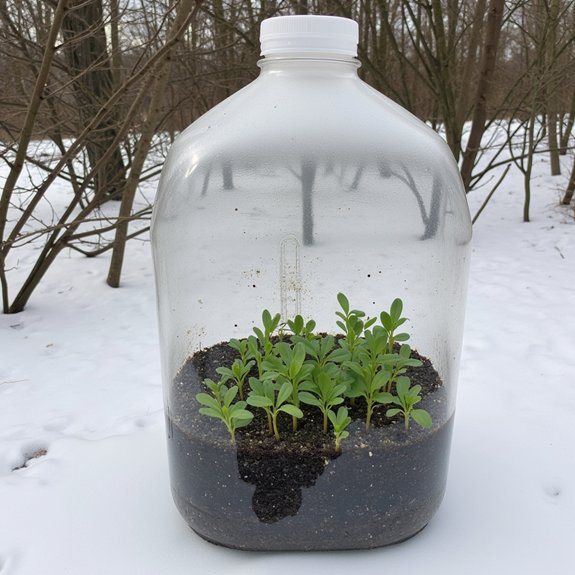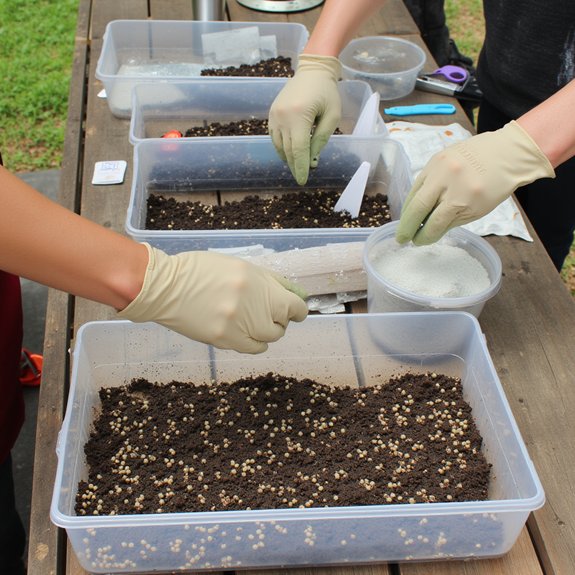You’ll skip the indoor seed-starting hassle, avoid transplant shock, and harvest more flavorful brassicas when you master winter sowing. This method transforms ordinary milk jugs into mini-greenhouses, letting nature handle the germination timing while you stay warm indoors. Your kale, Brussels sprouts, and cabbage will develop incredible cold tolerance, producing sweeter, more complex flavors than their pampered greenhouse cousins. But there’s a specific window for starting these containers, and missing it means waiting another year.
Contents
- 1 Understanding the Winter Sowing Method for Cold-Hardy Crops
- 2 Why Brassicas Are Perfect Candidates for Winter Sowing
- 3 Optimal Timing for Starting Your Winter Sowing Project
- 4 Essential Materials and Tools for Success
- 5 Step-by-Step Container Preparation and Seed Planting
- 6 Proper Placement and Protection Strategies
- 7 Monitoring Growth and Managing Seedling Development
- 8 Transplanting Your Hardy Seedlings to the Garden
Understanding the Winter Sowing Method for Cold-Hardy Crops

While indoor seed starting demands heat mats, grow lights, and constant attention, winter sowing lets nature do the heavy lifting for you. This method uses plastic containers as mini-greenhouses, protecting seeds while exposing them to natural temperature fluctuations. You’ll sow seeds in late winter, then let Mother Nature trigger outdoor germination when conditions are right.
The result? Exceptional seedling resilience that indoor starts simply can’t match. These tough plants handle transplant shock better, resist diseases, and adapt quickly to garden conditions. You’re fundamentally mimicking what happens naturally, but with added protection from your homemade greenhouse containers.
Why Brassicas Are Perfect Candidates for Winter Sowing
Because brassicas naturally thrive in cool weather, they’re ideally suited for the winter sowing method that mimics their preferred growing conditions. When exposed to cold temperatures, brassica varieties like kale, broccoli, and Brussels sprouts actually improve in taste through flavor enhancement. The cold stress converts starches to sugars, making your harvest sweeter and more complex.
Winter sowing eliminates the hardening-off process since your seedlings develop outdoors naturally. You’ll skip the damping-off fungal issues common with indoor starting. These hardy plants emerge stronger, handling transplant shock better than greenhouse-grown seedlings while saving you money on seed-starting equipment.
Optimal Timing for Starting Your Winter Sowing Project

When late December rolls around, you can start your winter sowing project for brassicas in most Northern Hemisphere locations. You’ll want to check your area’s best frost dates first, typically aiming for 6-8 weeks before the last expected frost. February works well for milder zones, while March suits colder regions perfectly.
Seed variety selection matters too. Hardy varieties like kale, Brussels sprouts, and cabbage handle winter conditions better than delicate types. The seeds won’t germinate immediately, they’ll wait until temperatures naturally warm up in spring, creating stronger seedlings than indoor-started plants.
Essential Materials and Tools for Success
Five basic materials will set you up for winter sowing success with brassicas. You’ll need transparent plastic containers like clear milk jugs or gallon-size Ziploc bags for your seedling supplies. Quality potting mix guarantees healthy germination, while a sharp knife or screwdriver creates essential drainage holes.
Container types matter greatly for ideal results. Milk jugs remain the most popular choice because they’re sturdy, offer excellent visibility, and feature removable tops for ventilation. Gallon bags provide flexibility but require dowel supports to prevent collapse.
Don’t forget clothespins for sealing bags and waterproof labels for identification throughout winter months.
Step-by-Step Container Preparation and Seed Planting

With your materials gathered, you’re ready to transform those containers into productive mini-greenhouses for your brassica seeds. Start container selection by choosing clear milk jugs or gallon Ziploc bags that allow 3-4 inches of soil depth. Create drainage holes using a sharp knife or screwdriver, spacing them every few inches along the bottom.
For soil preparation, fill containers with quality potting mix, leaving space at the top. Moisten the soil thoroughly before planting. Sow brassica seeds according to package directions, spacing them properly to prevent overcrowding. Press seeds gently for good soil contact, then water lightly.
Proper Placement and Protection Strategies
Once you’ve secured your containers, finding the right spot becomes essential for winter sowing success. Choose a location with full sun exposure, allowing your brassica seeds to receive maximum winter light. Position containers where they’ll experience natural weather patterns—rain, snow, and wind create stronger seedlings.
Container stability matters considerably in winter conditions. Use milk crates or aluminum trays to prevent tipping during storms. Avoid overly windy areas that might damage your setup.
Your containers need frost protection while maintaining exposure to elements. The mini-greenhouse effect protects seeds from harsh temperatures while permitting necessary cold stratification for ideal germination.
Monitoring Growth and Managing Seedling Development
After your containers are properly positioned outdoors, regular monitoring becomes your next responsibility for successful brassica development. Check soil moisture weekly, watering if the mix feels dry below the surface. Seedling health depends on consistent moisture without waterlogging.
Growth monitoring starts when sprouts appear in late winter or early spring. Open lids during warm, sunny days for ventilation, then close them at night or during frost warnings. Don’t worry if germination seems slow—this timing varies with your climate.
Strong winter-sown seedlings develop gradually, creating robust root systems that’ll outperform indoor alternatives once transplanted.
Transplanting Your Hardy Seedlings to the Garden
When frost danger has passed and spring temperatures consistently reach 65-70 degrees, your winter-sown brassica seedlings are ready for garden transplanting. These hardy plants won’t need hardening off like indoor-grown starts. Thin densely planted containers first, selecting the strongest seedlings for transplanting techniques that guarantee success. Space plants approximately 20 inches apart in well-prepared soil enriched with compost. Proper seedling care includes regular watering and gentle handling during the move. Your winter-sown brassicas will establish quickly, often outperforming nursery-bought plants. Treat them like any transplant initially, but expect faster adaptation to garden conditions.
